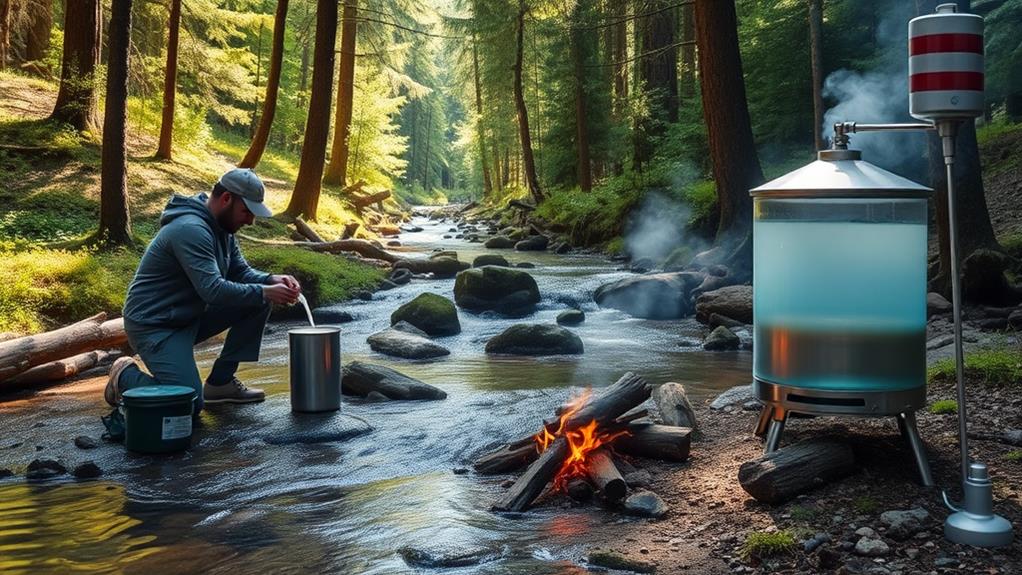
To guarantee wild water is safe to drink, you can use several effective methods. Boil the water for 1-3 minutes to kill pathogens. Filtration systems, including pump and gravity filters, remove contaminants. Chemical treatments with iodine or chlorine dioxide disinfect the water quickly. Solar purification (SODIS) uses the sun's UV-A rays to kill harmful organisms. UV light devices are efficient and easy to use for fast purification. Distillation involves boiling and condensing water to make it safe. You can even improvise with DIY methods like cloth filtering. Discover further details and tips by exploring these techniques.
Boiling
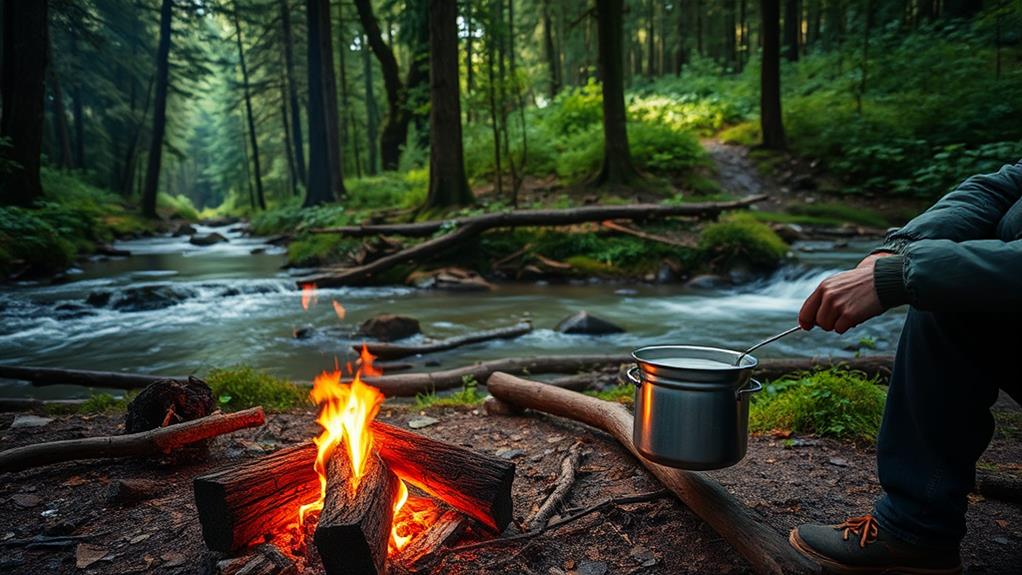
Boiling wild water is one of the simplest and most effective methods to guarantee it's safe for drinking. All you need is a heat source, a container, and some patience. By bringing the water to a rolling boil for at least one minute, you can kill most harmful organisms, including bacteria, viruses, and parasites. At higher altitudes, where the boiling point of water is lower, extend this time to three minutes to guarantee safety.
First, find a clean container, ideally metal, that can withstand high temperatures. Fill it with the water you've collected. Place the container over your heat source and wait until the water reaches a rolling boil. A rolling boil means the water is vigorously bubbling and churning. Keep it boiling for the recommended time.
After boiling, let the water cool naturally. Avoid adding ice or any foreign objects, as this could reintroduce contaminants. Pour the cooled water into a clean, sanitized container for storage.
Boiling doesn't remove chemical pollutants but is highly effective against biological threats. Always pair it with other methods if you suspect chemical contamination. Boiling confirms your wild water is drinkable and keeps you safe in the great outdoors.
Filtration Systems
While boiling is effective, filtration systems offer a convenient and versatile way to purify wild water, especially when you're on the move. These systems come in various forms, such as pump filters, gravity filters, and straw filters, making them adaptable to different situations.
Pump filters are great when you need water quickly. They usually consist of a hand pump that pushes water through a filter, removing bacteria, protozoa, and sediment. Gravity filters, on the other hand, use gravity to do the work for you. Simply fill the reservoir, hang it up, and let gravity pull the water through the filter. It's a hands-free option that's perfect for setting up camp.
Straw filters are ultra-portable and ideal for solo adventurers. You can drink directly from the water source by sucking through the straw, which contains a built-in filter. This method is quick and requires no setup, but it's best for personal use rather than group scenarios.
Chemical Treatments
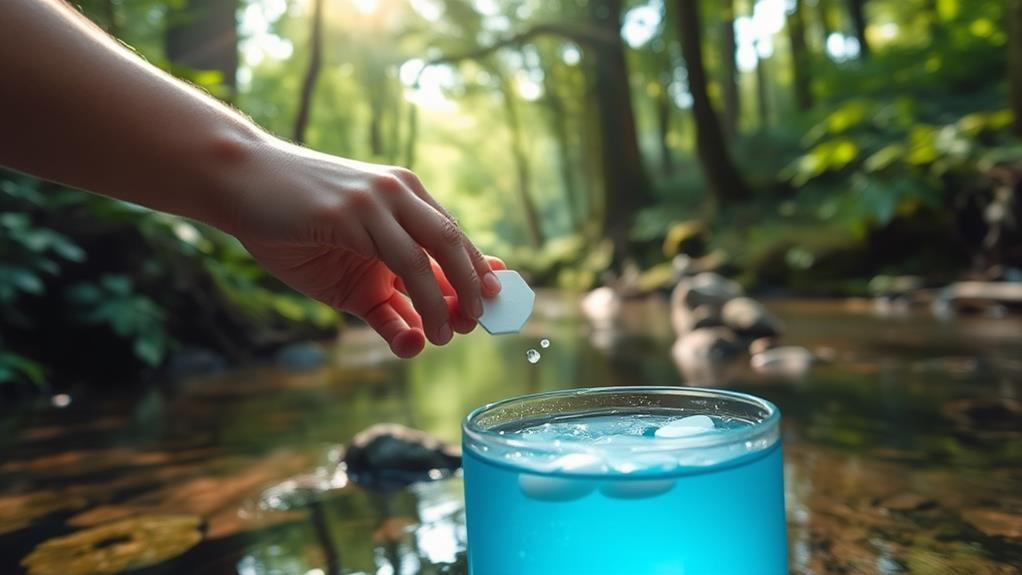
When you're in a pinch and need to purify water quickly, chemical treatments can be a lifesaver. These methods are efficient, lightweight, and easy to use, making them ideal for outdoor adventures. The two most common chemicals for water purification are iodine and chlorine dioxide.
Iodine tablets or drops are straightforward to use. Just add the recommended dosage to your water, stir, and wait about 30 minutes. Iodine is effective against bacteria and viruses but may not eliminate all protozoa. It's crucial to follow the instructions carefully to guarantee the water is safe to drink.
Chlorine dioxide is another popular choice. It's more effective than iodine against a broader range of pathogens, including Giardia and Cryptosporidium. Chlorine dioxide tablets are simple: drop them into your water, shake, and wait for the specified time, usually around 30 minutes to 4 hours, depending on the water's temperature and clarity.
One key advantage of chemical treatments is their portability. You can easily stash a small bottle of tablets in your backpack. However, always carry extra in case you lose some or need to purify more water than expected.
Solar Purification
Sunlight can be a powerful ally when it comes to purifying water in the wild. The method, often called SODIS (Solar Water Disinfection), is simple yet effective. You just need clear plastic or glass bottles and direct sunlight. Fill the bottles with water, making sure they're not too cloudy or dirty. If the water appears murky, filter it through a cloth first.
Place the bottles in direct sunlight, where they'll need to stay for at least six hours on a sunny day or up to two days if it's cloudy. The UV-A rays from the sun penetrate the water and kill harmful pathogens, including bacteria, viruses, and parasites. This method is most effective in areas with strong sunlight and clear skies.
Remember, the bottles should be clear, not colored, and free of scratches or other damage, as these can reduce the effectiveness of the sunlight. Also, don't use bottles larger than two liters, as the water might not heat evenly.
While solar purification is a reliable method, always guarantee you have enough sunlight and time. It's a great backup plan when you're out of chemical treatments or don't have access to a fire.
UV Light Devices
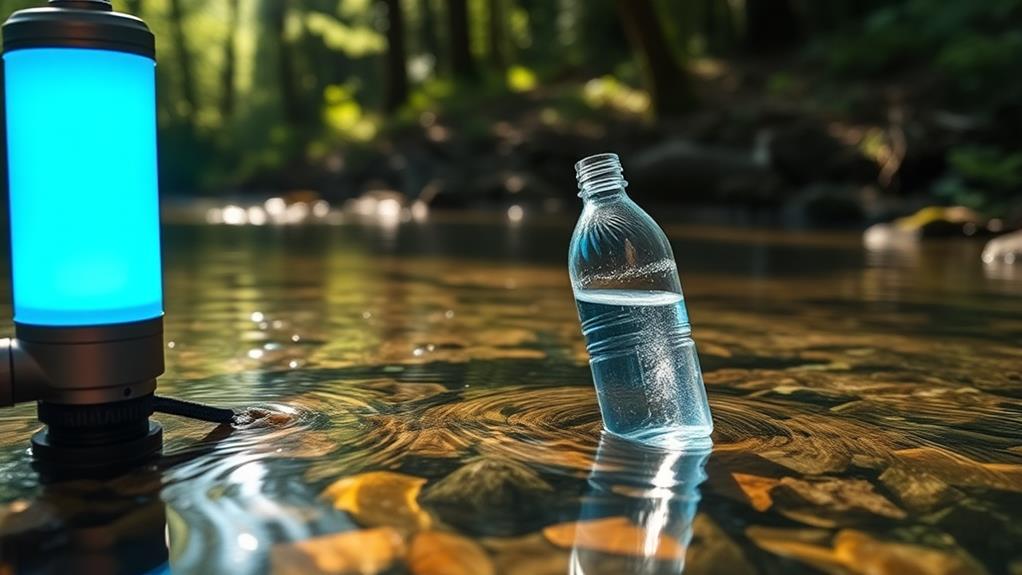
UV light devices have revolutionized the way we purify water in the wild. These handy gadgets use ultraviolet light to kill harmful microorganisms in water, making it safe to drink. They're incredibly effective and easy to use, making them a favorite among outdoor enthusiasts.
Here's why you should consider using a UV light device:
- Efficiency: UV light devices can purify water in just 60 seconds. That means you spend less time waiting and more time enjoying your adventure.
- Portability: Most UV light devices are lightweight and compact, fitting easily into your backpack without adding unnecessary bulk.
- No Chemicals: Unlike some purification methods, UV light doesn't require the use of chemicals, so you won't have to worry about any unpleasant tastes or potential side effects.
- Maintenance: These devices require minimal maintenance—just make sure the battery is charged, and you're good to go.
When you're out in the wild, a UV light device is a reliable tool for ensuring your water is safe to drink. It's a modern solution that combines technology with convenience, allowing you to focus on your adventure without worrying about water safety.
Distillation
Distillation is a time-tested method for purifying wild water that guarantees you get clean, safe hydration. It works by boiling the water to create steam and then condensing that steam back into liquid form, leaving contaminants behind. This technique effectively removes bacteria, viruses, and other impurities, ensuring the water you drink won't harm you. It's especially useful when dealing with saltwater or chemically contaminated sources.
To distill water, you'll need a heat source, a container for boiling, a way to capture the steam, and another container to collect the purified water. Although it requires some equipment, the result is worth the effort. Here's a quick overview of what distillation does:
| Contaminant Type | Removed by Distillation | Notes |
|---|---|---|
| Bacteria & Viruses | Yes | Safe to drink |
| Heavy Metals | Yes | Leaves contaminants behind |
| Salt | Yes | Ideal for seawater |
DIY Purification Methods
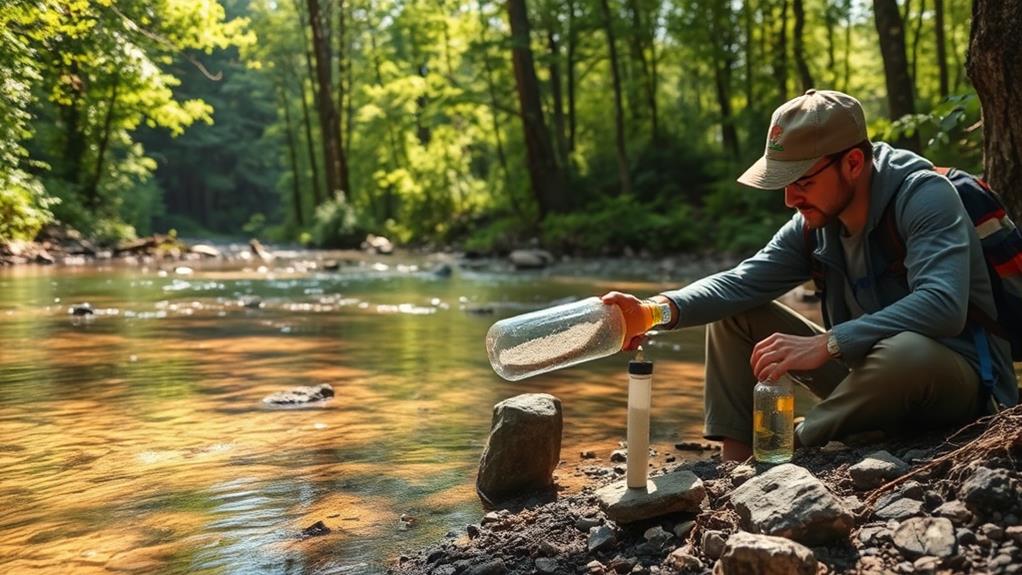
When you're out in the wild and need to purify water, DIY purification methods can be incredibly handy. You might not have fancy equipment, but with a bit of ingenuity, you can make water safe to drink. Four effective DIY methods you can use:
- Boiling: This is the most straightforward way to kill bacteria, viruses, and parasites. Bring water to a rolling boil for at least one minute. At higher altitudes, boil for three minutes.
- Solar Disinfection (SODIS): Fill a clear plastic bottle with water and leave it in direct sunlight for six hours. UV rays kill pathogens, making the water safer to drink. It's simple but requires sunny weather.
- Charcoal and Sand Filter: Create a layered filter using charcoal, sand, and gravel. Pour water through it slowly. The charcoal helps remove impurities and improve taste, while sand and gravel filter out larger particles.
- Improvised Cloth Filter: Fold a clean cloth several times and pour water through it. This won't remove pathogens but can filter out larger debris and sediments, making further purification steps more effective.
Using these methods, you can guarantee a safer drinking supply when you're far from civilization.
At a Glance
So, there you have it—seven effective ways to purify wild water to guarantee you stay hydrated and safe. Whether you're boiling water like your great-grandma did or using high-tech UV light devices, you'll find a method that works for you. Just remember, each technique has its pros and cons, so choose wisely based on your situation. Stay prepared, and you'll be ready to tackle any wilderness adventure without a hitch. Happy trails!






